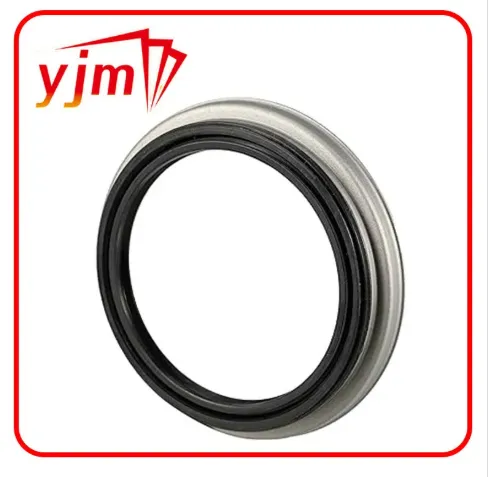Crank Pulley Oil Seals: A Small Component with Big Responsibilities
In every internal combustion engine, precision, sealing, and lubrication are crucial for efficiency and longevity. One often-overlooked part that plays a significant role in maintaining this balance is the crank pulley oil seal. This component, also referred to as the crank pulley seal, serves as a barrier to keep engine oil in and harmful debris out. Though it’s small and relatively inexpensive, its failure can lead to leaks, mess, and costly repairs.

What Is a Crank Pulley Oil Seal?
The crank pulley oil seal is located at the front of the engine, surrounding the crankshaft where it exits the timing cover and connects to the crankshaft pulley or harmonic balancer. Its main job is to prevent engine oil from leaking out of the front of the engine while still allowing the crankshaft to rotate at high speed.
Also known as a crank pulley seal, it is typically made of durable rubber or synthetic materials such as Viton or PTFE and is seated tightly within a metal housing. The outer lip seals against the crankshaft, while the outer edge sits snugly in the timing cover.
Key Functions:
Seals oil within the timing case or crankcase
Protects timing components and belts from oil contamination
Maintains engine oil pressure and cleanliness
Prevents dust, moisture, and debris from entering the engine
If this seal fails, it can lead to visible oil leaks from the front of the engine, dirty timing belts, or even engine misfires if the oil contaminates sensors or belts.
Symptoms of a Failing Crank Pulley Seal and Related Gasket
While a leaking crank pulley oil seal can sometimes be mistaken for other front-end oil leaks, there are a few telltale signs:
Oil visibly dripping or splashing from the front of the engine
Greasy residue on or around the crankshaft pulley or harmonic balancer
Unusual engine smells from burning oil near hot components
Decreased oil levels with no leaks visible under the oil pan
It’s also important to understand that this seal often works in tandem with a crank seal gasket, depending on the engine design. While the seal handles dynamic rotation, the crank seal gasket may be used on adjoining parts, like the timing cover, to ensure a leak-proof assembly.
In engines where both are used, replacing only the seal without inspecting or changing the crank seal gasket may not completely solve the leak problem. A proper repair involves cleaning the area, inspecting for crankshaft wear, and replacing both the seal and any worn gaskets.
Crank Seal Cost and Replacement Considerations
One of the biggest concerns vehicle owners have when faced with a front oil leak is the crank seal cost. The good news is that the part itself is relatively inexpensive. A standard crank pulley oil seal typically costs between $10 and $30, while high-performance variants may cost a bit more depending on material and brand.
However, the crank seal cost can increase significantly when labor is factored in. Because the crankshaft pulley and sometimes the timing belt or chain must be removed to access the seal, labor costs can range from $150 to $400 or more depending on the vehicle make and engine layout.
Factors That Influence Crank Seal Cost:
Make and model of the vehicle
Engine accessibility and front-end layout
Whether the timing system must be removed or reset
Location of the leak (some engines integrate the crank seal with oil pumps or covers)
If you’re already having work done on the timing system or crankshaft pulley, it’s often cost-effective to replace the crank pulley seal and inspect or replace the crank seal gasket at the same time.
Preventative Maintenance and Long-Term Reliability
While crank pulley oil seals are designed to last tens of thousands of miles, they can fail prematurely due to heat, age, contamination, or crankshaft wear. Here are a few maintenance tips to extend their life:
Use clean, high-quality oil: Dirty or degraded oil can erode seal material.
Inspect during timing belt service: Always check the crank pulley seal when servicing timing belts or chains.
Ensure proper crankcase ventilation: Excess pressure inside the engine can force oil past the seal.
Watch for pulley damage or misalignment: A bent crankshaft pulley or improperly installed harmonic balancer can distort the seal and lead to leaks.
If you plan to replace the crank pulley oil seal yourself, be sure to use the correct tool to remove and install the seal without damaging the crankshaft surface. Lubricate the new seal’s inner lip with clean oil during installation to ensure a smooth start-up.
The crank pulley oil seal, while small, plays a vital role in the health of your engine. Whether you’re dealing with a leaking crank pulley seal, evaluating crank seal cost, or replacing an old crank seal gasket, understanding the function and importance of these components can save you time and prevent major engine issues.
-
High-Quality Seal 12x22x5 for Industrial & Automotive Use | YJM Seal
Xəbərlər Nov.25,2025
-
Seal 12x20x5: Precision Radial Shaft Seals for Industrial Reliability
Xəbərlər Nov.24,2025
-
Seal 12x18x5: Essential Guide to Specifications, Applications & Vendors
Xəbərlər Nov.24,2025
-
Understanding Seal 12 20 5: Applications, Specifications & Industry Insights
Xəbərlər Nov.23,2025
-
Durable Oil Seal 85x110x12 – Reliable Sealing Solutions for Industry
Xəbərlər Nov.23,2025
-
Durable and Precise Oil Seal 75x95x10 for Efficient Machinery | YJM Seal
Xəbərlər Nov.22,2025
-
Durable Oil Seal 75x100x10 for Reliable Industrial Performance | YJM Seal
Xəbərlər Nov.22,2025
Məhsul kateqoriyaları















